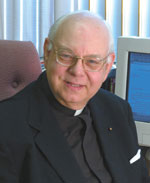Easter Sunday/Feast of the Resurrection of the Lord / Msgr. Owen F. Campion
The Sunday Readings
 Today, the Church celebrates Easter, the feast of the Lord’s Resurrection and the greatest day of the year.
Today, the Church celebrates Easter, the feast of the Lord’s Resurrection and the greatest day of the year.
These readings are proclaimed at Masses during the day on Easter Sunday.
On Holy Saturday, the Church celebrates the Easter Vigil, which is surely one of its most dramatic and expressive liturgical moments.
The first reading is from the Acts of the Apostles, a source that will be used often as the season of Easter progresses.
These readings, and certainly this reading, give us a glimpse into life in the early Christian community in Jerusalem, and into the lives of the 11 surviving Apostles after the Resurrection and Ascension of Jesus.
It is apparent that the words of Jesus, the risen Lord, were fresh in the minds of the Apostles and the other members of the community.
Strong also was their wish to follow the Lord’s instructions and his holy example.
In what today is called evangelization, the Apostles were committed to making the mercy of God in Jesus known to all people.
Here, St. Peter is the spokesman for all the Apostles. Indeed, throughout Acts, Peter appears as the head of the Apostles and of the Christian community in general.
For its second reading, the Church gives us a passage from St. Paul’s Epistle to the Colossians.
According to Paul, Christians also have been raised to new life. Their new life is in the resurrected, living Christ. As Christ is in heaven, so the thoughts of Christians must be on heaven.
St. John’s Gospel, with its moving Resurrection Narrative, provides the last reading.
Mary of Magdala was at the tomb, but found it empty. Upset, fearing that the Lord’s body had been stolen, she rushed to inform Peter. Reaching Peter, she anxiously explained that the Lord’s body had been taken away.
“The disciple whom Jesus loved”—traditionally thought to have been the Apostle John, but never actually identified as such in the Gospel—and Peter then hurried to the tomb. The disciple arrived first, but waited for Peter, another indication of Peter’s status.
Peter entered the tomb and saw that it was empty, but may not have realized that Jesus had risen, although the Gospel does not expressly say this. It does say that the other disciple “saw and believed” (Jn 20:8).
Reflection
These readings are powerful in their message. The centerpiece, of course, is the Gospel passage that highlights the experiences of Mary Magdalene, Peter and the Beloved Disciple as they find the Lord’s tomb empty.
The Gospel is remarkably detailed. The reactions of the principal figures are understandable.
In an age that has been so dismissive of religion, how authentic is the Church’s—and the Gospel’s—message that Jesus rose?
Was the Lord’s body stolen? It is most unlikely. Other readings say that soldiers guarded the tomb specifically to safeguard the body from being taken, and that a heavy stone sealed the entrance to the tomb.
In John’s account, the burial cloths were neatly folded. No thief would have taken the time for such care.
Very convincing is the fact that all four Gospels—while written at different times, in different places and by different authors—all agree that Jesus rose from the dead. Furthermore, it was the constant view among the first Christians.
In this reading, the Beloved Disciple alone understands what the empty tomb reveals. He already has been presented as a model of faith. It reminds us that faith opens our eyes.
Faith is essential in our own coming to believe that the Lord lives. It is more than accepting an intellectual proposition, however verified.
It is the acknowledgement that Jesus is the Lord of life, the source of life and the Son of God. Realizing that the Lord lives forever in all these roles is the ultimate wisdom. †
 Today, the Church celebrates Easter, the feast of the Lord’s Resurrection and the greatest day of the year.
Today, the Church celebrates Easter, the feast of the Lord’s Resurrection and the greatest day of the year.